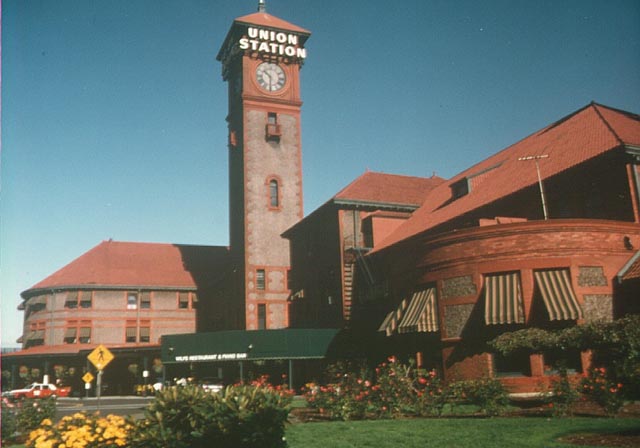Portland,
Oregon
Over 100 years ago, the grand new union
station in Portland, Oregon opened its doors to the public. Three railroads
entered the city, the Northern Pacific, the Oregon Railway & Navigation
Company, and the Oregon & California. Henry Villard, the entrepreneur who
fostered the development of the Northern Pacific was primarily responsible for
arranging the consolidationís that led to the building of Portland Union
Station.
Railroads
in the Pacific Northwest were often extensions of the water based
transportation companies that abounded during the late 19th
century. The Columbia, itís many tributaries and the coastal areas of the
northwest were ideally suited to river steamers. The coming of railroads from
the east and south would connect the Northwest territories to California and
the rest of the nation.
Portlandís
station was built on a site once occupied by a lake, and as such was (and is)
subject to flooding by the nearby Willamette River. More than 5300 wood pilings had to be driven into the marshy
ground to support the structure. Architects from the Kansas firm of Van Brunt
& Howe prepared plans for a large red brick station which features a
prominent high slender clock tower. Six
tracks served the station, and a roundhouse for locomotives was also built
nearby. Portland continued to
grow, and the station was expanded several times, adding additional passenger
sheds trackside, and a mail handling facility in 1915. The present brick
interlocking tower was completed in 1914, replacing a wooden structure. This
interlocking is the sole remaining active tower in the Northwest.
By
the 1920ís, the railroads had assumed the names we most often associate with
the station; Northern Pacific, Southern Pacific, and Union Pacific. During
World War I, services of the Spokane, Portland & Seattle and Great
Northern were consolidated at Union Station. A major remodeling of the station
occurred in 1927-1930. This gave the station its present lavish classical
marble interior, which remains today very well maintained. During the post
World War II era, the Streamliner Era ushered in perhaps the golden age of the
station. The classic ďGo By TrainĒ and ďUnion StationĒ neon signs were
added to the clock tower in 1948. SPís and UPís beautiful and colorful
consists graced the arrival and departure tracks in a never to be duplicated
pageant of the rails. I have been fortunate to have departed and arrived at
this station behind steam (and in a dome car, no less) on excursions sponsored
using UPís Challenger #3985 and SPís streamlined Daylight #4449. The sound
of a steam whistle and a dusting of coal or oil smoke still occasionally touch
this grand dame.
Portland
is fortunate that itís grand Union Station has remained, and is still home
to Amtrak services. (Note: Amtrakís Pioneer [Denver-Portland] was
discontinued in the last round of budget cuts.)
Forward thinking by the city of Portland has preserved itís railroad
station gateway, and today the site is the centerpiece for the North Downtown
redevelopment effort.

Portland,
Oregon. Rose bushes adorn the lawn area in front of Union Station,
October 1, 1995. The following
day, a Union Pacific steam excursion headed by Challenger #3985 would depart
from this stationís historic platforms.
JCD photo